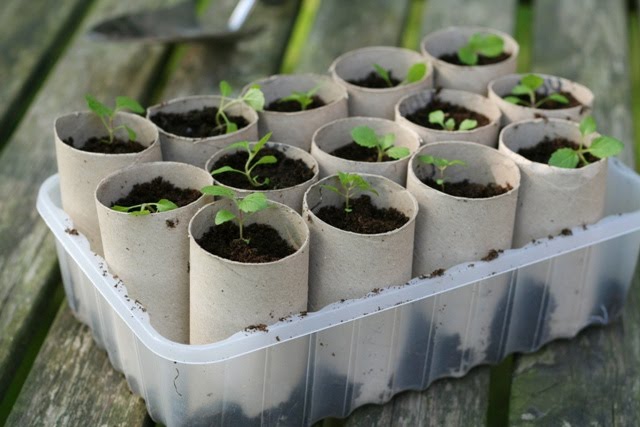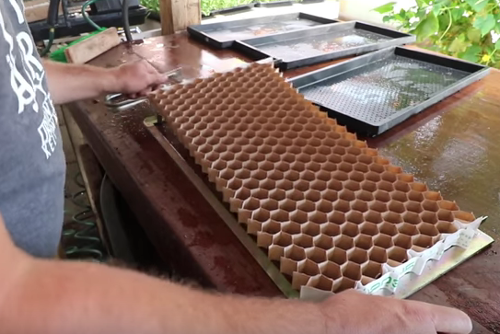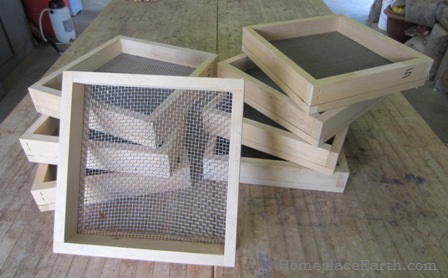So I have a beef with the folks who make those plastic seedling trays. Around here they cost a little over $5 each and they are about as flimsy as they could possibly be and yet survive the ride home to your place from the store.
They are so flimsy that they tend to crack and split even just washing them, let alone transporting one that's loaded with soil.
So you're forced to buy two at a time and stack them. Now your seedling flats cost $10 each and even then, a fully loaded one is prone to splitting.
If I were a cynical person I would tend to think this was all by design...
Since I have 500ft of growing beds to plant out in the spring, there is no way I'm prepared to bankroll one of these crappy manufacturers. There must be a better way I thought. And indeed there is.
Recall those awesome paper pot transplanters you can buy for the low price of $1,000? Well they use paper pots to start the seeds in. And got to wondering what the seedling stage of that system looks like.
As you can see, the paper pots themselves come in some sort of honeycomb configuration, and this sits in some special plastic tray.
Since I love the concept of taking a seedling in it's own pot and simply popping it into the garden just like the paper pot transplanter, I haven't had a lot of success with paper pots that I made out of newspaper.

Although the seedlings grew OK, they never really took off in the garden and I suspect it had something to do with the newspaper inhibiting root growth (because I dug them up later and had a look to find out why they weren't growing).
They were also a lot of work to make.
Then while I was studying the paper pot transplanter, it occurred to me that the people who invented this amazing device, probably got their inspiration from some sort of low tech system that existed before. But what could that be?
Then I realized that a low tech version of the paper pot transplanter flat looks a lot like a bunch of toilet paper rolls jammed together. Why I hadn't thought of toilet paper rolls before now is a mystery to me, but there they are already formed. And just like the paper pot transplanter pots, they are bottomless so root growth is unobstructed in the garden.
Now a toilet roll is about 4 inches long. But for most seedlings I only really need 2 inches of soil. I measured the depth of a commercial flat to confirm my assumption. So this means that every toilet paper roll produces two seedling pots if I cut it in half.
So I started hoarding toilet paper rolls through the winter. Cutting them in half, and folding them down to minimize the space they were taking up.
In the meantime I got to thinking about these annoying flats...
We do a decent amount of grocery shopping at No Frills, and as a result I need to break down the various cardboard boxes for recycling on a regular basis.
One evening as I was doing this chore, I noticed that the boxes fruit gets shipped in are particularly difficult to break down because they are made of really sturdy stuff.
"Hey, these would make awesome seed raising flats if only they were waterproof" I thought to myself as I struggled to break them apart.
I put one aside anyway because I also realized that they fit my seed screening frames nicely and I have some grains to clean.
Later that week I went to screen the wheat and barley I had harvested in the fall and found that the cardboard flat did indeed work quite well in collecting all the chaff that my screens separated out from the seed. But the cardboard flat had holes in it through which some of the finer chaff would fall and make a mess on the floor.
To fix this, I grabbed a plastic garbage bag and placed the cardboard flat inside. Encased in this plastic film, the flat was now sealed and I could screen my small grains without making a mess all over the place.
It then occurred to me that this plastic encased cardboard flat was also waterproof, and would make an excellent seedling flat for the cost of a plastic bag!
Cardboard flat, toilet rolls, and a plastic bag. I don't think it could be more low-tech than that.





No comments:
Post a Comment